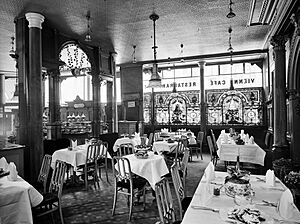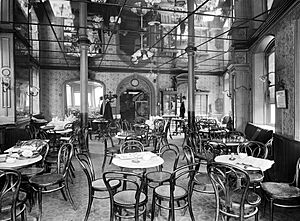Vienna Café facts for kids
The Vienna Café was a popular place to eat and drink located at 24–28 New Oxford Street in London. It was close to the British Museum and a famous library, making it a handy spot for people who loved books and learning. In the early 1900s, it became famous as a meeting place for writers, artists, and smart thinkers. Well-known visitors included Ezra Pound, H. G. Wells, and W. B. Yeats. The café was even mentioned in a famous travel guide from 1889. It closed in 1914, right after World War I started.
Famous Visitors
Many famous people visited the Vienna Café. The artist Wyndham Lewis first met Sturge Moore there around 1902. They became great friends. In 1910, Lewis introduced Sturge Moore to the American poet Ezra Pound. Pound, who lived in London for many years, often came to the café with Laurence Binyon, who worked at the British Museum.
Ezra Pound once wrote that he had lunch at the café after finishing one of his poems. Other famous people who visited included H. G. Wells, Amy Lowell, Henri Gaudier-Brzeska, and W. B. Yeats. Yeats even planned a lunch there with art critic D. S. MacColl in 1905. Ezra Pound later joked that Yeats complained the café closing was more annoying than a major battle during the war!
The poet Henry Newbolt called the group he met at the café the "Anglo-Austrians." They would have lunch after using the British Museum's Reading Room. This group included Laurence Binyon, Walter Crum, and others. Newbolt said they "lived mainly on excellent Viennese dishes" and talked very quickly and freely. The waiter, Joseph, was Italian.
Inside the Café
The café had a special triangular room on its first floor. This room had a mirrored ceiling that reflected everything below, "as if in a lake suspended above your head," as Wyndham Lewis described it. The writers often sat at a couple of tables on one side of this room.
According to writer Jeffrey Meyers, the café was a popular spot for people who had moved to London from other European countries. It was decorated in a style common in places like Austria, with red velvet chairs and seats. The owners were from Austria or Germany. When World War I began, people from these countries were sometimes seen as "enemy aliens" by the government. Because of this, the café had to close down.
The Café in Poetry
The Vienna Café was even mentioned in a long poem called The Pisan Cantos by Ezra Pound. He called it the "Wiener Café" in his poem. He wrote about how the café closed and how it marked the end of an era for the British Museum area, where many writers and artists gathered. He also remembered meeting Wyndham Lewis there, thanks to Laurence Binyon.



